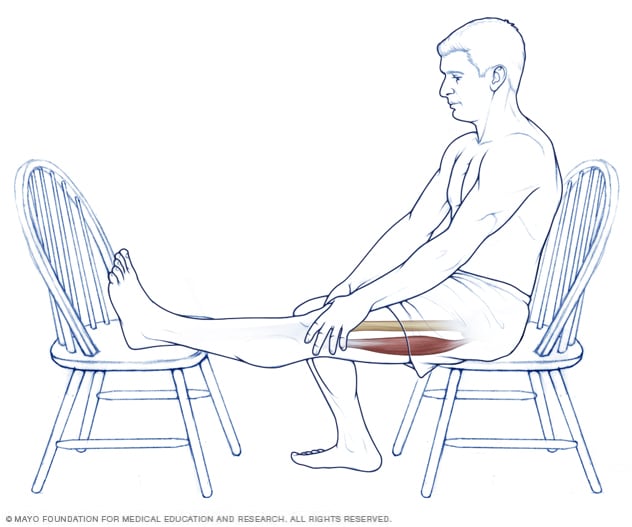Diagnosis
During the physical exam, a health care provider checks for swelling and tenderness along the back of the thigh. Where the pain is and how bad it is can give good information about the damage.
Moving the injured leg into different positions helps a provider pinpoint which muscle is hurt and whether there is damage to ligaments or tendons.
Imaging tests
In severe hamstring injuries, the muscle can tear or even separate from the pelvis or shinbone. When this happens, a small piece of bone can be pulled away from the main bone, known as an avulsion fracture. X-rays can check for avulsion fractures, while ultrasound and MRIs can show tears in the muscles and tendons.
Treatment
Hamstring stretch

Hamstring stretch
To stretch the hamstring muscles, extend one leg out in front. Then lean forward to feel the stretch in the back of the thigh. Repeat with the other leg. Don't bounce.
The first goal of treatment is to reduce pain and swelling. A health care provider might suggest the following:
- Take a break from strenuous activities to allow the injury to heal.
- Apply ice packs several times a day to relieve pain and reduce swelling.
- Wrap the injured area with a compression bandage or wear compression shorts to minimize swelling.
- Rest with the leg elevated above the level of the heart, if possible, to lessen swelling.
- Take pain medicine you can get without a prescription. Examples include ibuprofen (Advil, Motrin IB, others) and acetaminophen (Tylenol, others).
Physical therapy
Your health care provider or a physical therapist can show you how to do gentle hamstring stretching and strengthening exercises. After the pain and swelling go down, your provider can show you how to do exercises to build more strength.
Surgery
Most hamstring injuries that involve partial tearing of the muscles heal over time and with physical therapy. If the muscle has pulled free from the pelvis or shinbone, orthopedic surgeons can reattach it. Severe muscle tears also can be repaired.
Lifestyle and home remedies
To care for a minor hamstring injury yourself, try the R.I.C.E. approach:
- Rest. Take a break to rest your hamstring muscles and allow the damaged tissues to repair. Avoid any activity that causes pain, swelling or discomfort. If you have more than a minor muscle strain, your health care provider may recommend that you use crutches to keep your weight off the injured leg.
- Ice. Ice the area as soon after the injury as you can. For the first few days after the injury, keep an ice pack on the injured area for 15 to 20 minutes every 2 to 3 hours while you're awake. Cold reduces pain and swelling. It may also slow bleeding if there's a tear. If you have vascular disease, diabetes or can't feel much in your leg, talk with your care provider before icing.
- Compression. Wrap your leg with an elastic bandage until the swelling goes down. Be careful not to wrap too tightly. Begin wrapping at the end farthest from your heart. Loosen the bandage if the pain increases, the area becomes numb or swelling occurs below the wrapped area.
- Elevation. Sit or lie back with your leg raised while resting. If possible, raise your leg higher than your heart.
Pain medicine you can get without a prescription, such as ibuprofen (Advil, Motrin IB, others) and acetaminophen (Tylenol, others), also might help. After a few days, gently begin to use the injured leg. Your leg's ability to support your weight and your ability to move without pain should get better over time.
Preparing for your appointment
You might first talk to your own health care provider. You might be referred to a provider who practices sports medicine or does orthopedic surgery.
What you can do
Make a list that includes:
- Complete information about your symptoms and when they began.
- Information about medical problems you've had.
- All the medicines and supplements you take, including doses.
- Questions you want to ask the care provider.
What to expect from your doctor
Your care provider might ask some of the following questions:
- When did the injury occur and how did it happen?
- Did you feel a popping or tearing sensation?
- Do any movements or positions make the pain better or worse?
Dec. 09, 2022